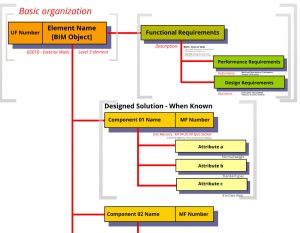Technology provides a means to connect data. Standards provide the organizations that make the data connections meaningful.
- BIM - Building Information Model using Revit software
- Specs - Construction Specifications using MasterFormat® organization
- PPD - Preliminary Project Description using UniFormat™ organization
So how are these related and just how can each be linked to the other?
Data Classification Standards
The Construction Specifications Institute (CSI) publishes both MasterFormat® and UniFormat™. These are industry accepted standards for organizing data about building construction. Both systems essentially look at the same building through different filters to present exactly the same information, but arranged very differently.
- MasterFormat classifies data by work results produced by construction trades.
- UniFormat classifies data by systems and assemblies representing functional elements.
MasterFormat is the standard for organizing construction specifications. The specifications are arranged as Sections within 50 Divisions.
UniFormat is a standard, first developed by estimators, for preliminary project estimates to allow comparisons and value analysis of entire assemblies during the design process. UniFormat is arranged in 8, Level 1 Elements.
BIM Objects
BIM allows designers to create buildings, virtually. Objects are placed and connected in the model to represent a building form. The objects (Revit families) are systems and assemblies. Exterior walls, for example, are BIM objects. A single object represents the entire exterior wall assembly with all the individual components - the exterior cladding, insulation, sheathing, framing, and interior finish.
Revit assigns 8-digit assembly codes to each object in the Type Properties window. The first 5 digits of the assembly codes are a UniFormat number. The last 3 digits are user (Revit) assigned to allow multiple objects of the same type. After all, many types of exterior wall assemblies are possible. Otherwise our environment would be a boring place.
What's a PPD?
PPDs allow designers to describe building systems and assemblies, the same way the buildings are conceived. Since PPDs are arranged using UniFormat, they can describe generic BIM objects, even before the designed solution for the project is known. This allows architects to work with generic objects until specific construction materials are selected.
How can PPDs help keep models generic longer? Well, exterior walls, for example, must perform certain functions regardless the designed solution. They prevent water and air penetration, provide thermal and wind load resistance, may be load bearing, and usually allow a view to the exterior for the building occupants. All these performance attributes may be described without knowing the wall is a masonry cavity wall or an insulated metal wall panel on metal framing. The Result: Architects can evaluate the performance and cost of alternative assemblies during early design phases before committing to specific assemblies.
PPDs are iterative, as is design. As design decisions are made, PPDs will describe the components required for each building system, adding more detailed information as designed solutions emerge.
Making the Link
BIM objects are identified by UniFormat assembly codes. PPDs describe BIM objects using the same UniFormat numbering scheme. PPDs also describe components that combine to form the building systems and assemblies. These components are usually the basis of construction specifications.
The example to the right shows how the PPD text can be linked to a construction specification section (gray background) and the data automatically extracted in an organization consistent with construction specifications. With this approach the PPD provides a valuable quality control function to begin the specification writing process.
But not all BIM data is contained in objects. Think of room data sheets. There is much data that can be associated with spaces rather than objects. In fact, many items required to complete a construction project may never be included in the building model, but are required none the less. These requirements can be identified as space properties and can be assigned an assembly code the same as for BIM objects. Through the magic of BIM scheduling capabilities, assigned space and object properties are easily extracted and reported for coordination with PPDs.
Now, What Do You Think?
- Are PPDs the construction Rosetta Stone?
- Can PPDs provide an understanding of generic BIM objects as the Rosetta Stone decree provided understanding of Egyptian hieroglyphs?
- Will PPD system and assembly descriptions extend BIM linking directly to construction specifications?
References
MasterFormat®
- Current Document: http://masterformat.com/
- History: http://en.wikipedia.org/wiki/MasterFormat
UniFormat™
- Current Document: http://www.csinet.org/uniformat
- History: http://en.wikipedia.org/wiki/Uniformat
PPDFormat™
- Current Document: http://www.csinet.org/Main-Menu-Category/CSI-Store/6/54e3e705-3f51-df11-bd27-0019b9e160b2.aspx
- Description: http://prezi.com/b2od9u-kbhfo/ppdformat/
Rosetta Stone http://en.wikipedia.org/wiki/Rosetta_Stone


